Think of your golf trolley battery as the heart of your setup. It's what turns a tough, hilly walk into a breezy stroll, letting you save your energy for the game itself. While older, back-breaking lead-acid models used to be the only option, today's lightweight, long-lasting lithium batteries have completely changed the game with their massive leap in performance and convenience.
Your Guide to Choosing the Right Golf Trolley Battery
Welcome to the only guide you'll need for powering your electric golf trolley. Making the right choice here is a game-changer, ensuring you get a full, uninterrupted round every time you head out. Let's face it, nobody wants to be stranded on the back nine with a dead battery. The good news is, today’s technology offers options that are miles ahead of the clunky, unreliable power sources of the past.
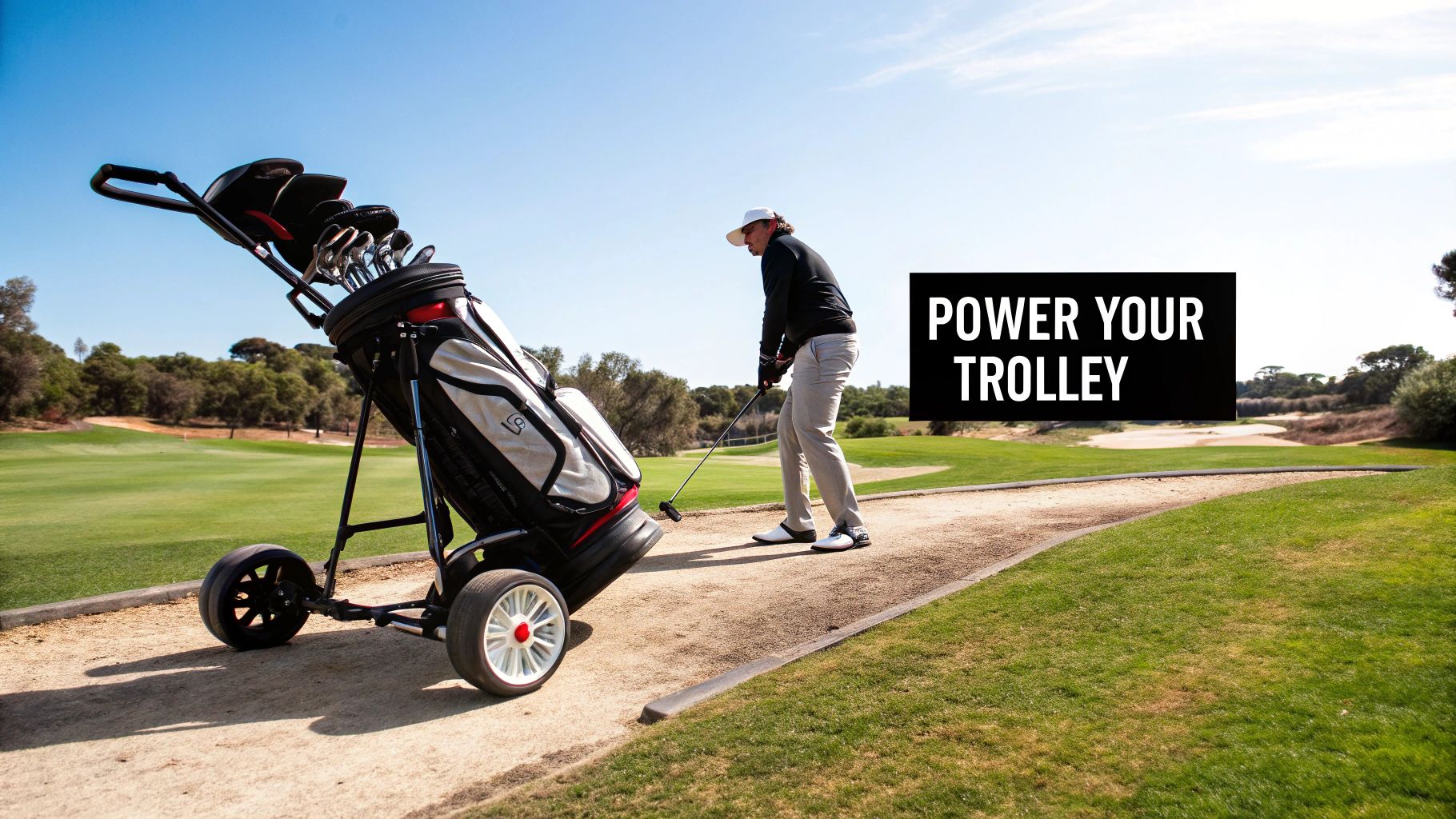
This guide will break down everything you need to know, from comparing battery types to understanding what all the technical jargon actually means for you on the course. Think of it as an investment in your enjoyment. A reliable battery lets you focus on your swing, not on whether your trolley has enough juice to conquer that next big hill.
What You Will Learn
We’re going to cover all the essentials to help you make a smart, informed decision. By the time you're done reading, you’ll know exactly how to pick and maintain the perfect battery for your trolley.
Here’s a sneak peek at what’s ahead:
- Technology Showdown: We'll put traditional Lead-Acid batteries head-to-head with modern Lithium options in a clear, no-nonsense comparison.
- Decoding the Specs: We’ll translate technical terms like Voltage (V) and Amp Hours (Ah) into what they actually mean for your round of golf.
- Making the Right Choice: You'll get a practical checklist to help you find a battery that perfectly matches your trolley, how often you play, and your budget.
- Extending Battery Lifespan: We’ll share some simple, easy-to-follow tips to help you get the most performance and value out of your purchase.
This shift to better battery tech isn't just a golf thing; it's happening everywhere. The golf cart battery market alone was valued at around USD 181.36 million and is expected to surge to USD 322.32 million by 2035. That’s a huge indicator of how much demand there is for more efficient power on the course. You can discover more insights about the golf cart battery market growth and what’s driving it.
Consider this your go-to resource. We'll give you clear explanations and real-world advice to make sure your trolley is always ready to go, so you can walk the course with total confidence.
Lead-Acid vs. Lithium: The Great Battery Debate
When it comes to powering your golf trolley, you're looking at a classic showdown: old-school reliability versus modern-day performance. It’s not just about picking a battery; it’s about choosing a power philosophy that fits your game. Understanding the real-world differences is the key to making an investment you won't regret.
Think of it this way: the traditional Lead-Acid battery is like a trusty, old pickup truck. It’s been around forever, it’s dependable, and it’s easy on the wallet upfront. On the flip side, the modern Lithium-ion battery is like a sleek sports car—unbelievably light, powerful, and ready to go after a quick refuel.
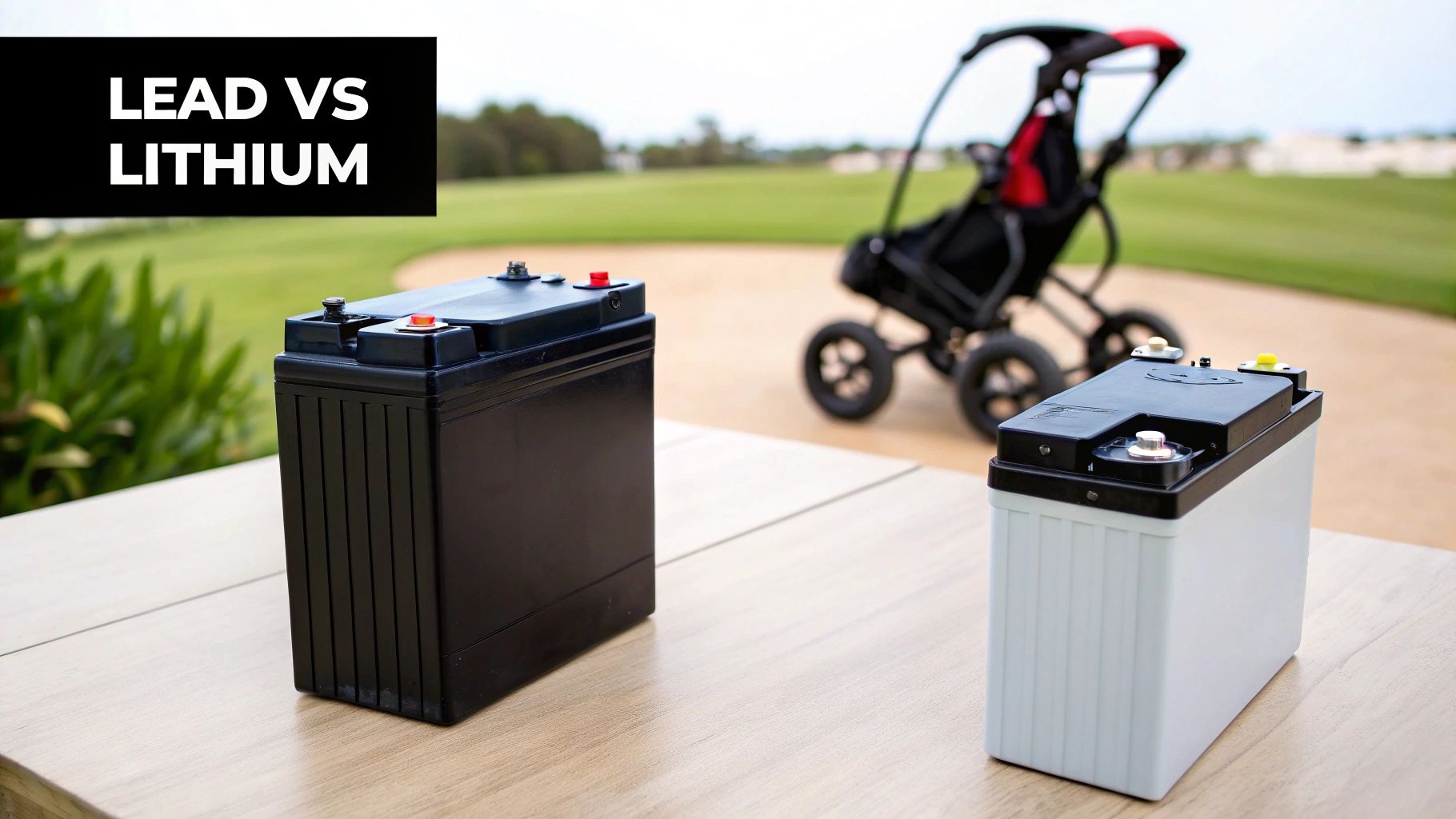
Sure, both will get you around the course. But the experience, convenience, and long-term value are worlds apart. Let's settle this great battery debate and figure out which one is right for you.
The Old Guard: Lead-Acid Batteries
For years, lead-acid batteries (including Sealed Lead-Acid, AGM, and Gel types) were the only game in town. Their main draw has always been a low initial price tag, which made them the go-to choice for many golfers getting into electric trolleys.
But that lower upfront cost comes with some serious baggage—literally. The most obvious drawback is the weight. A typical lead-acid battery tips the scales at 10-12 kg (22-26 lbs). Lifting that in and out of your car before and after a round is a workout in itself.
Beyond the sheer heft, their performance is pretty limited. They need a long time to charge up, often taking 8-10 hours to get back to full power. Their lifespan is also a weak spot, usually lasting for only 200 to 400 charge cycles before the capacity starts to fade fast. That means you could be buying a replacement every couple of seasons.
The Modern Champion: Lithium-Ion Batteries
Lithium-ion technology has completely changed the game for golf trolleys, winning in just about every category that matters. The first thing you'll notice is the staggering difference in weight. A comparable lithium battery weighs a mere 2-3 kg (4-6 lbs), making it up to 75% lighter than its lead-acid cousin.
This isn't just about saving your back. A lighter battery puts less strain on your trolley's motor and frame, which can help extend its life. Lithium batteries also recharge in a fraction of the time, with most models hitting a full charge in under 5 hours.
But the real knockout punch is their longevity. A quality lithium battery can handle up to 2,000 charge cycles—that’s up to five times more than a lead-acid battery. While they do cost more initially, this incredible lifespan often makes them the cheaper option in the long run.
The move to lithium isn't just a trend; it's a full-on market takeover. Lithium-ion batteries now command 48.23% of the global market, and that number is only expected to grow. Why? Superior energy density, a much longer life, and virtually zero maintenance. You can dig into the lithium battery market trends to see why they're quickly becoming the new standard.
This market shift simply reflects the real-world benefits that golfers are experiencing on the course every single day.
Head-to-Head Comparison
To lay it all out, let's put these two side-by-side and see how they stack up.
| Feature | Lead-Acid Battery | Lithium-ion Battery |
|---|---|---|
| Weight | Heavy (10-12 kg / 22-26 lbs) | Lightweight (2-3 kg / 4-6 lbs) |
| Lifespan | Short (200-400 cycles) | Long (Up to 2,000 cycles) |
| Charging Time | Slow (8-10 hours) | Fast (Under 5 hours) |
| Maintenance | Regular (Watering, cleaning) | None required |
| Upfront Cost | Low | High |
| Long-Term Value | Lower | Higher |
In the end, it boils down to what you value more: short-term savings or long-term performance and convenience. If you only play a handful of times a year, a lead-acid battery might do the trick. But for any regular golfer, the benefits of lithium—the lighter weight, faster charging, and incredible durability—make for a much better ownership experience and a smarter investment over time.
Decoding Battery Specs: Voltage and Amp Hours
When you’re staring at a new golf trolley battery, the label can look like a mess of technical jargon. But two of those specs—Voltage (V) and Amp Hours (Ah)—are the only ones you really need to get right. Nail these two, and you’ll have a trolley that performs exactly how it’s supposed to.
Think of Voltage (V) as the horsepower in your car’s engine. It’s the raw “push” that gets the electrical energy from the battery to your trolley's motor. More push means a stronger, more consistent flow of power, which is why matching the voltage to your trolley's motor is completely non-negotiable.
If your trolley was built for a 12V system, you absolutely must use a 12V battery. Slapping in a battery with lower voltage won't give the motor enough juice, leading to sluggish performance or a trolley that won't even start. On the flip side, using a higher voltage battery is a great way to fry the motor and electronics for good.
Voltage: The Unwavering Rule
The good news is that most electric golf trolleys today run on a 12V system—it’s the industry standard. Some older models or high-performance trolleys might be different, so it's always smart to double-check the user manual or the label on your old battery before you buy a replacement.
While things are pretty straightforward for trolleys, the wider golf cart market is a different story. Power needs have evolved, but 6V batteries still dominate globally, holding 40.01% of the market share. You'll also see higher voltage options like 24V, 36V, and 48V for bigger carts that need more power and range. You can read the full research about these golf cart battery trends to see just how much power requirements can vary.
The Golden Rule of Voltage
Always match the battery's voltage to your trolley's specified voltage. There's no room for error here—it’s the most critical factor for compatibility and safety.
Once you’ve locked in the correct voltage, the next decision is all about how long you want your trolley to run. That brings us to Amp Hours.
Amp Hours: The Fuel in Your Tank
If voltage is the engine's power, then Amp Hours (Ah) is the size of the fuel tank. It’s all about capacity. A bigger tank (a higher Ah rating) lets you drive farther, and a battery with more Amp Hours will last longer on a single charge. Simple as that.
This number tells you exactly how much energy the battery can store, which directly translates to how many holes you can play before it dies.
- 18-Hole Batteries (Standard Capacity): These are usually in the 18Ah to 22Ah range. They’re built to get you through a standard 18-hole round on a mostly flat course with a reasonably light bag.
- 36-Hole Batteries (Extended Capacity): These beefier batteries typically run from 24Ah to 33Ah. They pack enough power for two full rounds or give you a nice safety buffer for one really demanding round.
So, which one is for you? It really comes down to how and where you play. A golfer on a hilly course will burn through a battery way faster than someone on a flat, links-style track. The weight of your bag and even how wet the ground is will make the motor work harder and use more power.
This is why a lot of golfers grab a 36-hole battery even if they only plan on playing 18. It’s pure peace of mind, ensuring you’re not the one whose trolley gives up on the 16th hole. If you're ever curious about how much juice your current battery actually has left, you can learn more in our practical guide on how to test battery capacity right at home.
At the end of the day, understanding these two simple specs lets you look at any battery and know exactly what to expect. Just match the voltage, then pick the capacity that fits your game.
How to Choose the Right Battery for Your Trolley
Picking the right battery for your golf trolley doesn't need to be a head-scratcher. Once you get the hang of the different technologies, it really just boils down to a simple checklist. By answering a few quick questions about your gear and how you play, you can confidently find a power source that won't let you down on the links.
Think of it like getting fitted for a new driver. You wouldn't just grab one off the rack without considering your swing speed or shaft flex, right? Your battery choice should be just as personalized to make sure it delivers, round after round. Let’s walk through the essentials to find your perfect match.
Start with Trolley Compatibility
First things first, you absolutely have to make sure the battery is compatible with your trolley. This is the non-negotiable starting point, because a mismatch can kill performance or even damage your equipment.
There are three critical points to check:
- Voltage: The vast majority of modern trolleys run on a 12V system. Double-check your trolley’s manual or the label on your old battery to be certain. Using the wrong voltage is a fast track to problems.
- Size and Dimensions: Your trolley's battery tray is built to specific measurements. The new battery needs to fit snugly and securely. If it’s too big, it won't fit at all. If it's too small, it could rattle around during your round and damage the connections.
- Connector Type: The two most common connectors you'll see are the T-bar and the Anderson plug. While you can find adapters, it’s always better to get a battery with a connector that matches your trolley's plug for the most secure and efficient power transfer.
This decision tree infographic breaks down the first two big considerations when choosing a battery—matching the voltage to your trolley and the amp-hours to your course.
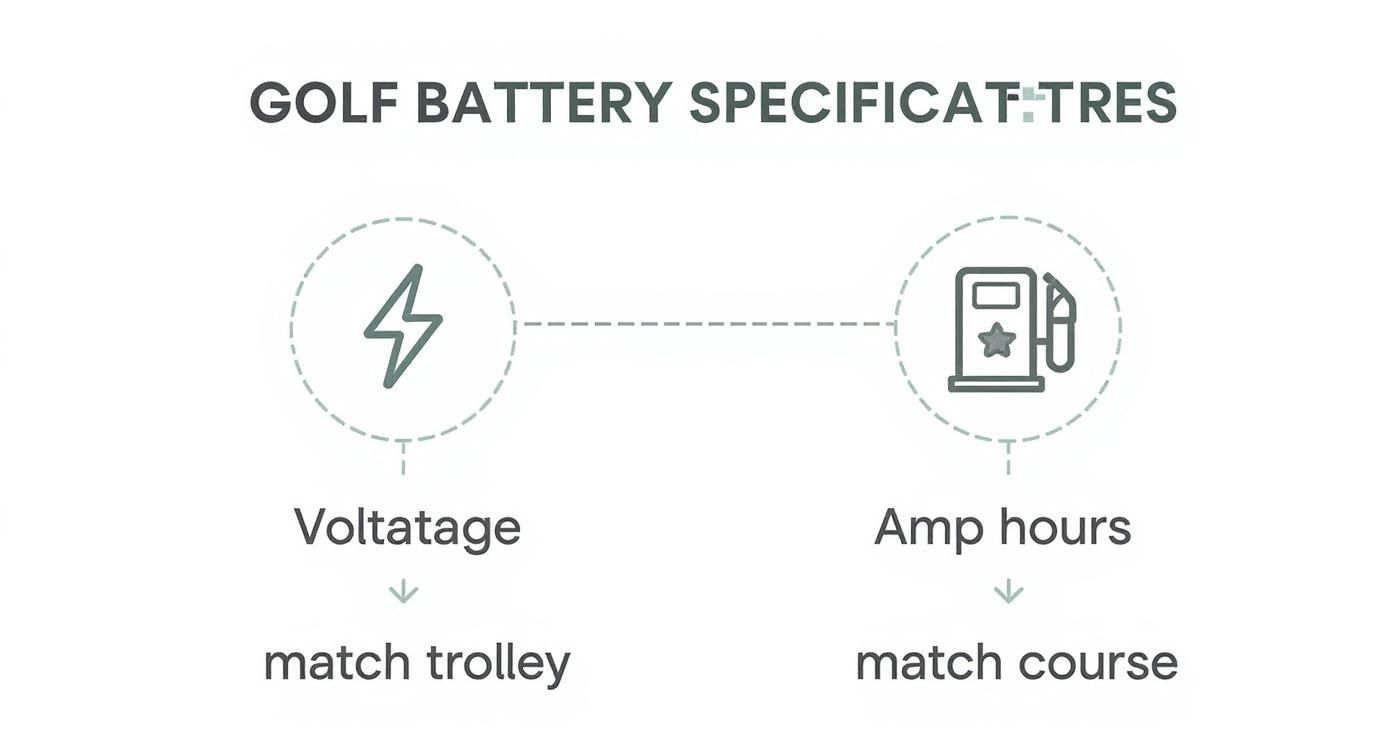
As the visual shows, nailing the foundational specs like voltage and capacity is the most important part of the entire process.
Analyze Your Playing Habits
With compatibility locked in, the next step is to pick a capacity that suits your game. The battery's Amp-hour (Ah) rating is what determines how long it will last on a single charge. Your habits and the courses you play are the best guide here.
Ask yourself these questions:
- How many holes do you usually play? If you’re an 18-hole golfer, a standard-capacity battery (around 18-22Ah) will do the job. But if you love playing 36 holes in a day, you'll definitely need an extended-capacity battery (24Ah or more) to go the distance.
- What are your courses like? A trolley climbing a long, hilly course chews through way more energy than one cruising on a flat, short track. If your home course is a beast, going for a higher Ah rating gives you a much-needed performance buffer.
- How heavy is your golf bag? A heavier bag puts more strain on the motor, which means higher power consumption. It's a simple but often overlooked factor.
Choosing an extended-capacity battery even for 18-hole rounds is a smart move. It reduces strain on the battery by not draining it completely, which can help extend its overall lifespan and gives you peace of mind that you'll never run out of power.
Consider Your Budget and Portability
Finally, it's time to weigh your budget against long-term value and pure convenience. A lead-acid battery might have a lower upfront cost, but its shorter lifespan means you could end up buying three or four of them in the time a single lithium battery would last. While a lithium battery is more expensive at first, it often has a much lower total cost of ownership.
Weight is another game-changer. If you struggle with lifting heavy items, the 75% weight savings of a lithium battery is a massive plus. Hoisting a 2-3 kg lithium battery is a world away from managing a hefty 10-12 kg lead-acid model, making your pre- and post-round routine that much easier.
This simple convenience can make a surprisingly big difference in your overall enjoyment of the game.
Maximizing Your Battery's Lifespan and Performance
Dropping a chunk of change on a new golf trolley battery is an investment in your game, so you'll want to make sure it lasts. Proper care isn't complicated, but you need to know that different batteries have different needs. Think of it like a car—you wouldn't put the same oil in a vintage classic as you would a brand-new electric vehicle.
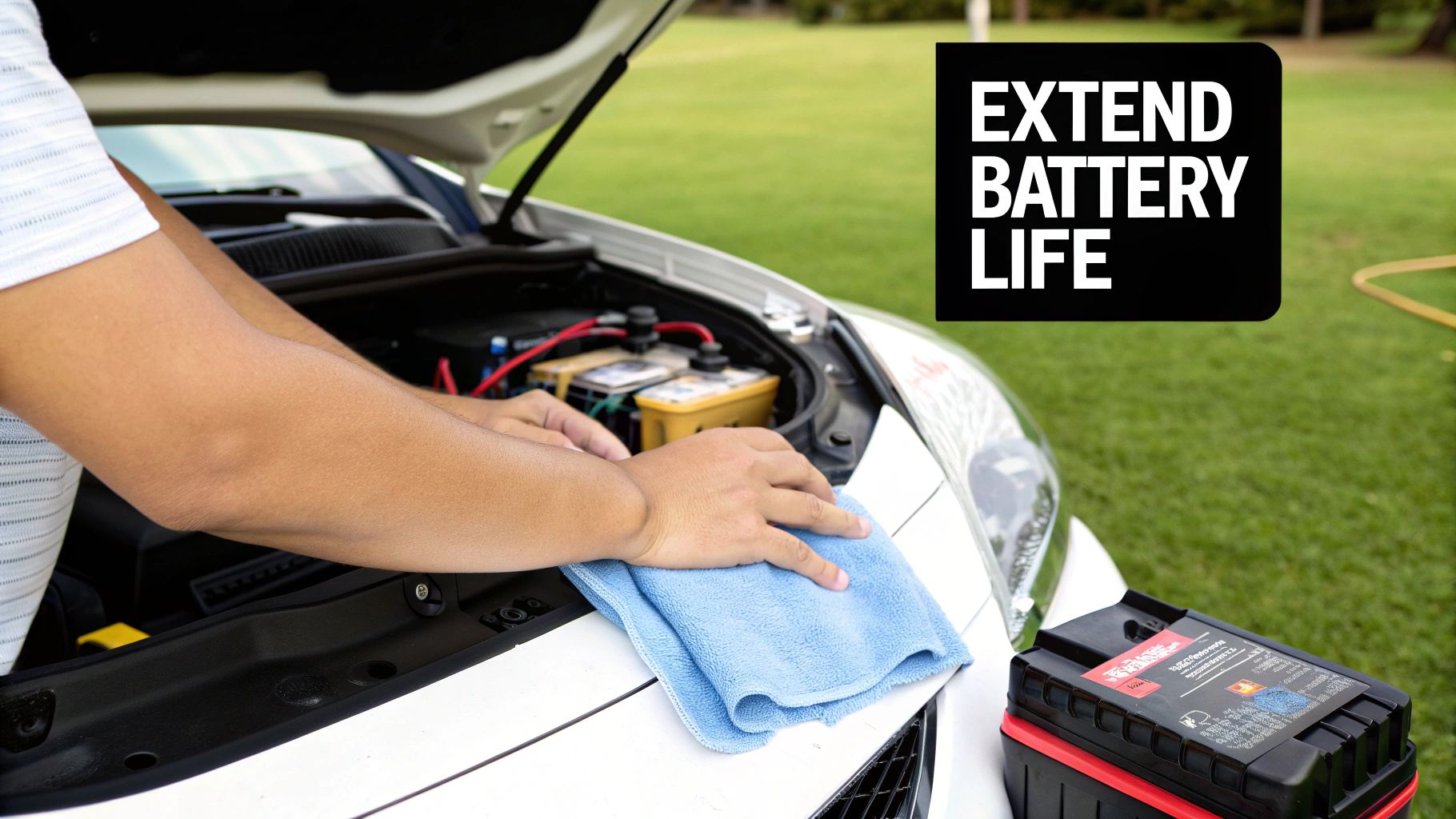
The two main players, Lead-Acid and Lithium, have their own simple maintenance routines. Stick to these guidelines, and you’ll squeeze every bit of performance and longevity out of your battery, keeping you on the course for years to come.
Caring for Traditional Lead-Acid Batteries
Lead-acid batteries are the old-school workhorses of the trolley world. They're reliable, but they need consistent attention to stay in fighting shape. Their internal chemistry makes them vulnerable to damage if you neglect them, but a few simple habits can dramatically extend their life.
The golden rule? Charge it after every single round, no exceptions. It doesn't matter if you played nine holes or a full eighteen. Leaving a lead-acid battery even partially discharged is the fastest way to kill it, thanks to a process called sulfation where tiny crystals build up and choke its ability to hold a charge.
On top of that, make these practices part of your routine:
- Don't Run It Empty: Try to avoid draining the battery completely flat. Deep discharges put a massive strain on the internal plates.
- Keep the Terminals Clean: Give the terminals a quick check for corrosion now and then—it looks like a white, powdery crust. A simple wipe with a baking soda and water paste will keep the connection clean and strong.
- Top Off the Water: If you have a non-sealed ("flooded") battery, you'll need to top up the cells with distilled water occasionally. This stops the internal plates from drying out and getting damaged.
Maintaining Modern Lithium Batteries
One of the best things about lithium batteries is their "plug and play" nature—they're practically maintenance-free. But "low-maintenance" doesn't mean "no-care." A couple of good habits will protect your investment and ensure it delivers peak performance for its entire lifespan, which can be 10 years or more.
The number one rule here is to always use the charger that came with the battery. Lithium batteries have a smart little computer inside called a Battery Management System (BMS). This BMS talks to the charger to make sure the battery gets a safe, efficient charge. Using the wrong charger can fry the BMS or the battery itself.
Your battery’s longevity is directly tied to its charging habits. While robust, lithium batteries are sensitive to improper charging and extreme temperatures. Consistently following best practices is the secret to unlocking their full potential.
For those who really want to geek out on modern power sources, you can dig into these expert tips for maximizing lithium-ion battery lifespan to learn even more. Smart storage is another huge factor. Don't leave your battery in extreme heat or freezing cold, like in the boot of your car on a hot day or in an unheated garage during winter. High temperatures speed up degradation, and trying to charge a frozen lithium battery can cause permanent, irreversible damage.
For a deeper dive, check out our complete guide on how to extend battery life and get the most out of your gear.
A Quick Guide to Off-Season Storage
When it's time to hang up the clubs for the winter, don't just toss your battery in the garage and forget about it. Storing it properly is crucial to making sure it’s ready to go when the season starts again.
The process is a little different depending on what type of battery you have.
Seasonal Battery Storage Checklist
| Step | Lead-Acid Battery | Lithium-ion Battery |
|---|---|---|
| Initial Charge | Charge it fully before storing. | Charge to about 50-70%. Never store it full or empty. |
| Disconnect | Disconnect the battery from the trolley. | Disconnect the battery from the trolley and the charger. |
| Storage Location | Store in a cool, dry place (50-60°F / 10-15°C). | Store in a cool, dry place (50-60°F / 10-15°C). |
| Maintenance Charge | Top it up every 4-6 weeks to prevent sulfation. | No maintenance charge needed due to low self-discharge. |
| Pre-Season Check | Fully charge it 24 hours before your first round. | Fully charge it before your first round of the season. |
Following these simple steps will ensure your battery wakes up from its winter hibernation healthy and ready to power you through another season on the links.
Troubleshooting Common Battery and Charger Issues
Even the best golf trolley batteries can have a bad day. It’s frustrating when your trolley starts acting up mid-round, but the fix is often much simpler than you think. Before you start planning a trip to the pro shop, a few quick checks can help you figure out what’s wrong and get back on the course. Think of this as a first-aid guide for your trolley's power source.
Most problems boil down to a few usual suspects: a weak connection, an old battery that’s seen better days, or a charger that’s given up the ghost. By checking each part of the system one by one, you can usually find the root of the problem yourself. Let's walk through the most common issues and how to solve them.
My Battery Is Not Holding a Charge
This is probably the most frequent complaint we hear. You leave it charging overnight, only for it to die somewhere on the back nine. A battery that can't hold its charge is often just nearing the end of its life, especially if it’s an older lead-acid model that has been through hundreds of charge cycles.
But before you rush out to buy a replacement, check these things first:
- Loose Connections: Jiggle the terminals where the battery connects to the trolley. Are they snug? A loose connection can stop the battery from charging properly and cause the power to cut out when you hit a bump.
- Corroded Terminals: Take a look at the metal terminals on the battery. See any white, chalky gunk? That’s corrosion, and it’s a master at blocking the flow of electricity. You can clean it off easily with a wire brush and a simple paste made from baking soda and water to get a solid connection again.
If the connections are clean and tight but the battery still won't last 18 holes, it's a safe bet the battery itself is the problem. A lithium battery will typically last 5 times longer than a lead-acid one, so if you find yourself constantly dealing with this issue, upgrading might actually save you money in the long run.
My Trolley Seems Sluggish or Slow
Is your trolley struggling to get up hills or moving at a snail's pace on flat ground? That's a classic sign that the battery isn't delivering enough power. This is often the first warning sign that your battery’s capacity is starting to fade. It might still take a charge, but it can no longer push out the consistent voltage your trolley's motor needs to perform at its best.
A sluggish trolley is like trying to run a marathon after a poor night's sleep; the energy just isn't there. The battery might show a full charge, but its internal chemistry has weakened, reducing its ability to provide strong, sustained power.
It's also worth checking for other things holding it back. Make sure your trolley's wheels are free of mud and grass and that they spin easily. Any extra resistance forces the motor to work harder and will drain the battery much faster. If the wheels are clean and the path is clear, a dying battery is the most likely culprit.
Understanding Your Charger Lights
Charger lights can feel like they're speaking another language, but they’re giving you important clues. A solid red light usually means it's charging, and a solid green light means you’re fully charged and ready to go. It’s the blinking lights that often signal something is wrong.
A flashing red or green light can mean a few different things:
- A Bad Connection: The charger isn't making good contact with the battery.
- Battery Fault: The battery is either too drained to accept a charge or has an internal failure.
- Charger Fault: The charger itself might be broken.
The easiest way to figure out if it's the battery or the charger is to borrow a charger you know works, maybe from a friend or the local pro shop. If your battery charges up fine on their charger, then you know you just need a new charger. For trickier issues, reading a guide on the specifics of a lithium battery charger for a golf cart can give you a much deeper understanding of how these smart systems work and what their different error codes are telling you.
Frequently Asked Questions About Golf Trolley Batteries
It’s natural to have questions when you’re dealing with the power source of your golf trolley. Getting the details right can save you a lot of headaches down the road. This section tackles some of the most common things golfers ask, giving you quick, clear answers so you can get the most out of your gear.
Can I Use a Car Battery in My Golf Trolley?
That’s a hard no. While it might seem like a clever workaround, car batteries and golf trolley batteries are built for completely different jobs. Think of a car battery like a sprinter—it’s designed to deliver one massive burst of energy to crank an engine over.
Your golf trolley needs a marathon runner. That's why they use deep-cycle batteries, which are engineered to provide a steady, consistent stream of power over a long period. Using a car battery will give you terrible performance and it'll die a quick death, since it just isn't designed to be drained and recharged over and over again.
How Long Should My Golf Trolley Battery Last?
The lifespan of your battery really boils down to two things: its type and how well you treat it. Here’s what you can generally expect:
- Lead-Acid Batteries: With proper care, a traditional lead-acid battery should get you through three to five years of rounds. The key is to be disciplined about charging it after every single use.
- Lithium-ion Batteries: These are the modern workhorses and a true long-term investment. A quality lithium battery can easily last for 10 years or more, and it’s not uncommon for them to outlive the trolley itself.
Can I Leave My Battery on the Charger Indefinitely?
This is another one where the type of battery makes all the difference. If you're using an older lead-acid battery and charger, leaving it plugged in is a bad idea. Those older chargers don't always know when to quit, and overcharging can seriously damage the battery.
Modern lithium battery chargers, on the other hand, are much smarter. They come with a built-in Battery Management System (BMS) that acts like a brain, automatically cutting off the power once the battery is full. This prevents any risk of overcharging, making them much safer to leave plugged in.
Key Takeaway: Even with a smart charger, it's still a good habit to unplug your battery once it’s fully charged. It's a simple step that helps ensure maximum safety and can add to your battery's overall lifespan, no matter what kind you have.
Ready to make pushing your cart a thing of the past? The Caddie Wheel offers a powerful, lightweight, and easy-to-install solution to upgrade your existing push cart. Experience the freedom of a motorized trolley and walk the course with less effort. Find your Caddie Wheel today and transform your game.

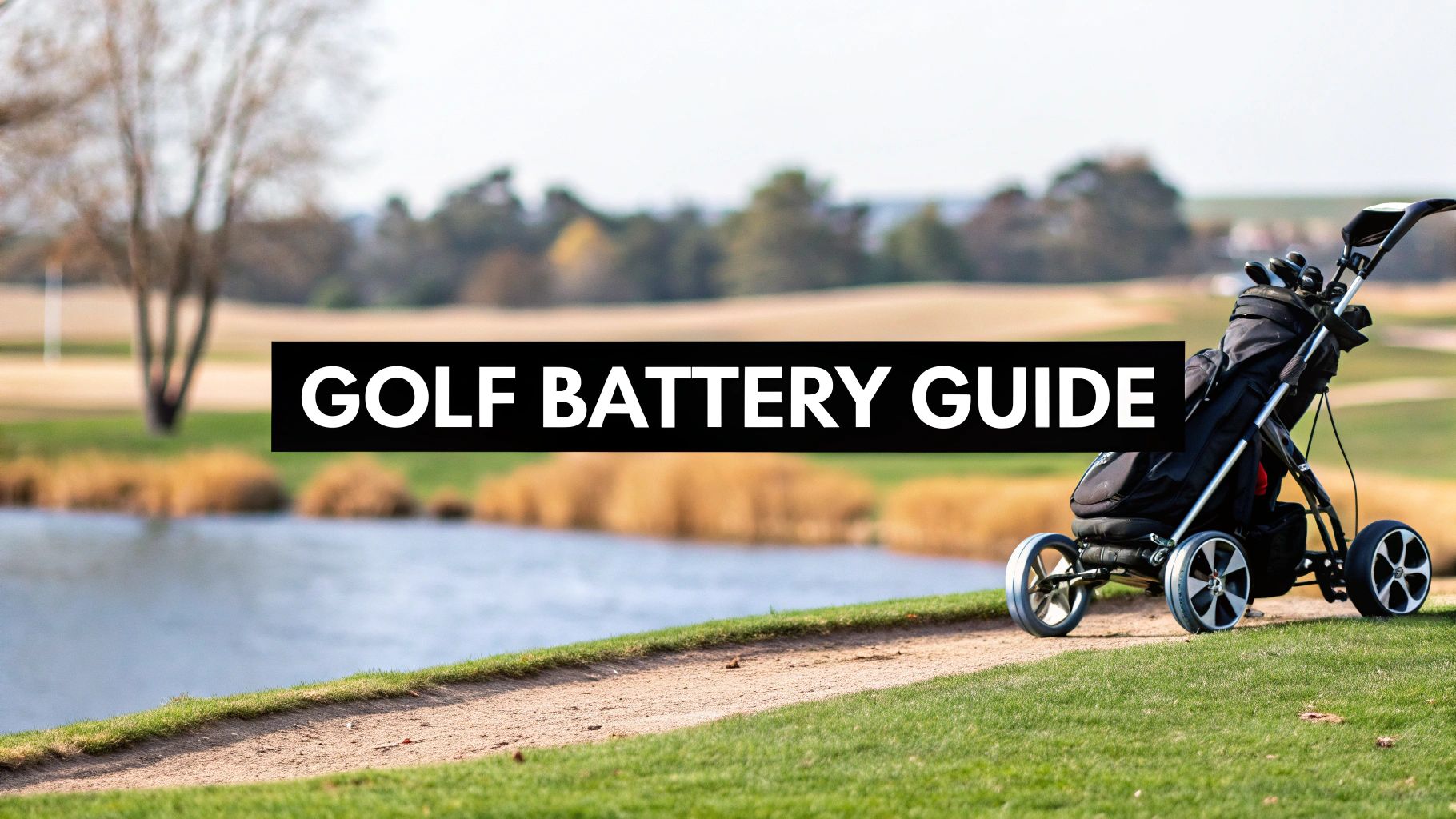
Share:
Your Guide to the Golf Cart Charging Cord
Guide to three wheel golf cart electric: Benefits & Picks